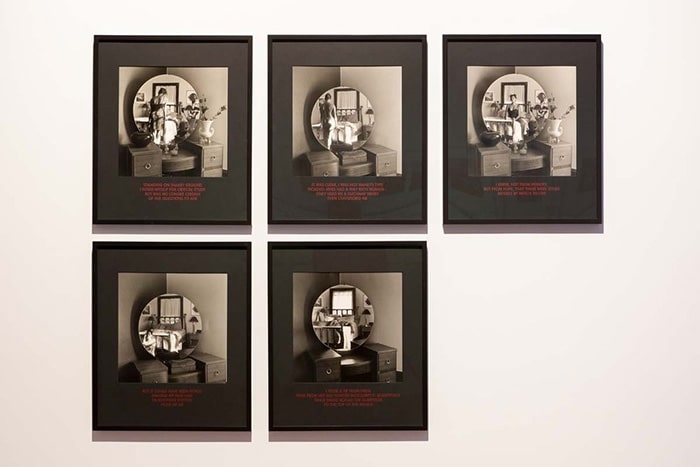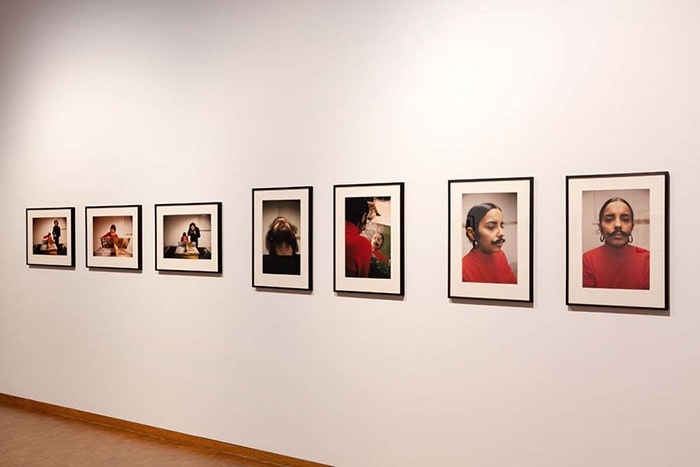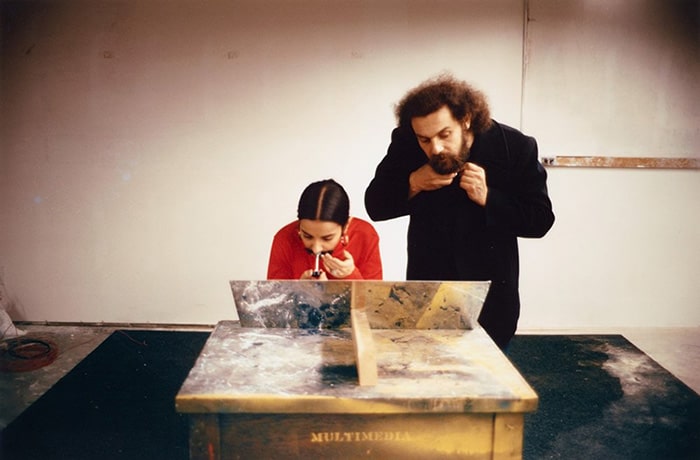The starting point of the photo room presentation is the work Master Rituals II: Weston Nudes by Tarrah Krajnak (*1979 Lima, Peru, lives in Los Angeles, USA). In the eighteen-part series from 2020/2021, the artist recreates female nudes taken by the North American photographer Edward Weston from 1927 onwards and published after his death in 1977. In her work, Krajnak shows herself as photographer and model in one. Her appropriation of Weston’s photographs refers to the traditional hierarchical relationship between artist and model, in which the part of the model presented as passive is faded out. Furthermore, her performative and photographic act targets the canon of Western photography, which is characterised by a white idea of ideal femininity.
image above: Ana Mendieta, Facial hair transplant, 1972, colour photograph 32.5 x 48.5 cm, Museum Ludwig, Cologne, © VG Bild-Kunst, Bonn 2023 * Reproduction: Rheinisches Bildarchiv, Cologne.
VALIE EXPORT (*1940 Linz, Austria, lives in Vienna, Austria) is represented with photographs from her series Body Configurations from 1976. A woman in everyday clothes is integrated in various postures into the architectural forms of Vienna’s Burgtheater. The passivity of her respective positioning is reflected by the titles of the individual photographs: The woman’s body is fitted into a stately representative building from the 19th century. During this period, the bourgeois notion of gender characters was formed, according to which private space as a place of reproduction is female and public space as a place of production is male.
Sanja Iveković (*1949 Zagreb, Yugoslavia, lives in Zagreb, Croatia) dealt with the contradictory image of women of the regime before the disintegration of Yugoslavia. In the series Sweet Life from 1975-1976, she combines voyeuristic snapshots from tabloids with private shots of herself, which, due to their similarity, give the impression of a connection in terms of content. They are accompanied by excerpts from headlines such as “insieme al ‘night'” (together all night), “skandalozna” (scandalous) or “Popularni iza pozornice” (Popular behind the scenes). Their salaciousness goes back to the separation of private and public spheres in bourgeois society around 1900, in which women were relegated to the private sphere.

The photo series Untitled (Facial Hair Transplants) by Ana Mendieta (*1948 in Havana, Cuba, d. 1985 in New York, USA) documents a performance in which she glues on her beard hair. It was created in 1972 as a final project for Mendieta’s painting studies at the University of Iowa. That year she began to use her own body, using materials such as blood, feathers, stones, flowers and smoke.
In her 1997 series Not Manet’s Type, the artist Carrie Mae Weems (*1953 Portland, Oregon, USA, lives in Syracuse, NY, USA) shows herself in various postures, including as a nude model, via the diversions of a make-up mirror. In her accompanying text, Weems notes with biting derision that modern European painters did not choose black women as models; their beauty was excluded. In doing so, she addresses the uncertainty from which angle to approach the subject: as an artist or as a model? On the level of observation, she reverses the uncertainty: The mirror frames the intimate scene and convicts the viewer of voyeurism.

All the selected works, which were created over a period of about fifty years between 1972 and 2021, have in common that their own bodies are brought into the work performatively and photographically. Using the body as a medium, the artists examine the power formations effective in their respective social environments and make them visible.
WHERE?
Museum Ludwig
Heinrich-Böll-Platz
50667 Köln
WHEN?
Exhibition days:
Saturday, 22 April – Sunday, 27 August 2023
Opening hours:
Tue – Sun (incl. public holidays): 10 – 18 h
Closed on Mondays (except public holidays)






